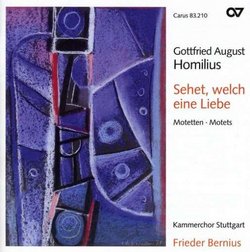| All Artists: Homilius Title: Homilius: Sehet Members Wishing: 0 Total Copies: 0 Label: Carus/Albany Original Release Date: 1/1/2004 Release Date: 1/1/2004 Genre: Classical Style: Number of Discs: 1 SwapaCD Credits: 1 UPC: 409350832109 |
Search - Homilius :: Homilius: Sehet
CD Details |
CD ReviewsA voice teacher and early music fan George Peabody | Planet Earth | 06/29/2009 (5 out of 5 stars) "VIBRANT AND EXPRESSIVE SINGING FROM THE KAMMERCHOR STUTTGART SURELY WOULD MAKE FOR A HAPPY HOMILIUS(WHEREVER HE MAY BE).
Gottfried August Homilius (1714-1785) was the greatest cantor of Dresden's Kreuzchor, and for a time a student of J.S.Bach. His greatest work is probably his St.Matthew Passion, which is similiar to Bach's large vocal works. His style combines the expansive Thuringian-Saxon motet with the shorter, liturgical introit motet and with the sensitive cantabile style of his time. The motets based on biblical passages fall into two groups: those with and those without a basic chorale (hymn). This excellent recording by Bernius and the Kammerchor Stuttgart includes an almost equal number of motets from both groups. The chorale motets display a broad contrapuntal array of techniques with their variety of ways of treating chorales. The more homophonic motets show interesting harmonic turns and tense building-up of phrases and sections wich are always closely related to the meaning of the text. The translucent beauty of the music is complimented on this CD by fine singers and brilliant recording skills. Homilius wrote a considerable number of motets that clearly reflect their liturgical purpose. Most of them are rather short, and all of them, at least those that are on this disc, are from texts in the Bible, either the New Testament or the Book of Psalms. The inclusion of chorales in some of the motets also reflect their liturgical use. In the liner notes, Uwe Wolf characterizes the use of these chorales "as a way to make a connection between 'art and rite'". The motets are written in the musical language of the time between Baroque and Classical. They are sometimes homophonic, although Homilius does make use of counterpoint occasionally. However, they are somewhat connected with the past, both in the use of chorales and the writing for double chorus. Although these motets are quite different from Bach's motets, they share a common spirit born of similar harmonic choices and functions, the special use of dissonance, and in the attention to particular words and their emphasis through rhythmic and/or harmonic means, which shows why it's so important for performers to understand and execute the music with appropriate articulation and energy, as these Stuttgart singers demonstrate so successfully. The impressive quality of these motets goes along with an equally impressive performance by the Kammerchor Stuttgart under the capable leadership of Frieder Bernius, whom I personally seek out because of his excellent grasp of Early Music (try some of his Zelenka recordings;superb). The clarity of the choral sound, the immaculate phrasing and articulations, perfect intonation and the fine shaping of the musical lines as well as the way the text is treated- these characteristics make this recording one of the finest choral performances of recent times. Hearing this choir gives me great joy." |

